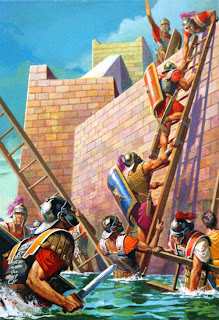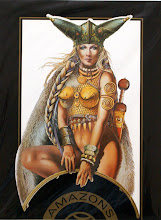When Dick Ayers was inducted into the Will Eisner Comic Book Hall of Fame in 2007, it was in recognition of his talents as both an inker and penciller. In the former category, he famously inked the work of Jack Kirby when Kirby was at his peak in the 1950s and 1960s, including early episodes of
The Fantastic Four; as a penciller he is best known for his work on
Sgt. Fury and his Howling Commandos, his work winning the Alley Award for Best War Title in 1967 and 1968.
Richard Bache Ayers was born on 28 April 1924 in Ossining, New York, the son of John Bache Ayers, an insurance agent, and his wife Gladys Adelia (nee Minnerly), and could trace his ancestors back to pioneers who settled at Newbury Plantation, Massachusetts, in 1635. He was raised in Poultney, near Lake Cayuga, and later said that growing up on his uncle's farm contributed to his ability to draw horses. Ayers served with the Army Air Corps during the Second World War.
Ayers published his first comic strip in the military newspaper
Radio Post in 1942. After leaving the army, he took an adventure story he had written and drawn to Dell Comics; they planned to publish it but the project was scrapped before publication. In 1947, he was taking evening classes at Burne Hogarth's Cartoonists and Illustrators School in New York City where he met Superman co-creator Joe Shuster, who would drop in to visit classes, and Marvin Stein, who was teaching classes as well as being Shuster's chief assistant. Visiting Shuster's nearby studio, Ayers began producing occasional pencils for
Funnyman.
Shuster also introduced Ayers to Vin Sullivan of Magazine Enterprises where he began drawing
Jimmy Durante and Western strips for
A-1 Comics and
Trail Colt. Ayers co-created The Calico Kid as a back-up for
Tim Holt comic. Whenever trouble loomed, the spineless Calico proved to be a master gunfighter. After five episodes, he revealed an even deeper secret: he was in truth Federal Marshal Rex Fury. Attacked and left for dead, Fury is visited by the ghosts of those who tried to tame the wild west – Wild Bill Hickok, Kit Carson, Calamity Jane and others – and Fury survives with their skills somehow imprinted on him. Dressed in a phosphorescent costume and riding a white stallion named Spectre, he becomes The Ghost Rider.
After his debut in
Tim Holt #11, The Ghost Rider soon earned his own title in 1950, which Ayers continued until 1954. He also added stories featuring
Bobby Benson's B-Bar-B Riders, based on the boy cowboy of the popular radio series, to his schedule in 1952. At the same time, he began working for Atlas Comics (the forerunner to today's Marvel Comics), drawing horror stories and a revival of The Human Torch.
Ayers was so busy, he employed Ernie Bache as an assistant and set up a small studio in the kitchen of an apartment owned by his wife's employer. In a
2001 interview, Ayers recalled:
Side-by-side we worked for—oh, that was '52. It wasn't until '55 when that damn Wertham thing came and killed all our books, The Ghost Rider and Human Torch. So we were down and we had, mostly, just Charlton. We didn't quite make it.
I lettered first and then I would pencil, and then I'd ink the outlines and then I'd give it to Ernie. Ernie would erase the page [laughs] and then he would finish it. He would put on all the blacks and the Kraft-Tone and bring in all that stuff. So we made a good team. I didn't bother throwing in heavy blacks. I would start them, maybe, but then he would accentuate the lines I'd put in, make them a little stronger. And he was very meticulous in his approach. I mean, everything had to be a certain formula so that we could knock out four pages a day, so he was a good asset for me.
The comic book industry was devastated by the introduction of the Comic Code Authority, who banned anything considered dangerous to juvenile morals. Horror and crime stories disappeared almost overnight and, after 167 stories, The Ghost Rider also fell victim to the sweeping industry changes. Work for Charlton Comics'
Crime and Justice and
Racket Squad in Action also disappeared.
Ayers' attempt at a superhero, The Avenger, lasted only one issue (it was continued by Bob Powell) and a Ghost Rider replacement, The Presto Kid (a cowboy magician who debuted in
Red Mask #51), lasted only a few episodes.
Ayers subsequently concentrated on his work for Atlas, drawing back-up features win
Kid Colt Outlaw,
Outlaw Kid,
Wyatt Earp and
Rawhide Kid and, from 1959, inking Jack Kirby's monster stories in
Strange Tales,
Journey Into Mystery,
Amazing Adventures,
Tales to Astonish and
Tales of Suspense and over two years of the syndicated newspaper strip 'Sky Masters of the Space Force' (1959-61).
As Atlas introduced new characters, and because Kirby was their go-to artist for new strips, Ayers found himself inking the first appearance of The Rawhide Kid (revamped in 1960), Ant-Man (
Tales to Astonish #27, 1962), The Human Torch (first solo story,
Strange Tales #101, 1962), Sgt. Fury and his Howling Commandos (1963), and early issues of The Fantastic Four, Thor and The Incredible Hulk (all in 1962).
Inking was a means to an end. Ayers "only inked to survive in comic books and support my family, which included my wife, 4 children and mother-in-law."
When asked in 2003 who he enjoyed inking, Ayers replied, "No one."
In 1964, Ayers took over completely from Kirby as penciller of
Sgt. Fury with issue 8, beginning an almost unbroken decade-long run on the comic that was to last until issue 120. The series was penned by Stan Lee, Roy Thomas and, from 1967, by Gary Friedrich. The team of Friedrich, Ayers and inker John Severin turned the book into a recognisable classic; the Howling Commandos and their cigar-chomping leader, Nick Fury, battled around the world in a series of gritty, strongly moralistic stories which were often as negative about war as they were celebrations.
Initially, Ayers had wanted to come off the title:
I didn't like Kirby's pencilling of Sgt Fury and asked off after the 3rd issue. I was in the Army 1942 – 1945 and it didn't connect with how I pictured "army." When Stan put me on to pencilling it, it wasn't until I recalled how it was when, getting into the combat zone, we would exaggerate out combat stories to each other and do anything we could to look different from the others around us. I got a shoulder holster and .45 and wore ski sox and a silk scarf. Then Sgt Fury and His Howling Commandos became real to me.
In the 1970s, Ayers switched from Marvel to DC Comics, where he pencilled war stories for
Star Spangled War Stories,
Army at War,
All-Out War and other titles. At the same time he pencilled various other series, including
Kamandi, The Last Boy on Earth (1976-78),
Unknown Soldier (1977-82),
Scalphunter (1977-81),
Sergeant Rock (1978-81) and
Jonah Hex (1979-84). "I was able to accomplish 4 books a month. There'd always be a script for me every time I delivered my pencils," Ayers
recalled. "As a result I think I did some of my best storytelling at DC. I was asked to pencil tight leaving the blacks and tones for the inker. It enabled me to do some of my best story telling in Kamandi, Jonah Hex and Unknown Soldier and all the other DC books they had me do."
In the 1980s, Ayers worked for a number of different companies, including Archie, Modern Publishing and Comico, and in the 1990s for Revolutionary and Topps. In 1984-85 he also drew promotional comics for Comic Shack featuring the Tandy Computer Whiz Kids. In 1985 he also accepted the National Cartoonists Society Award for Best Comic Book.
Ayers taught at the Joe Kubert School, his students including Tom Mandrake, Jan Dursemma and Karl Kessel.
Ayers' early work was rediscovered in 1990 and reprinted by AC Comics, although due to Marvel's copyright on a different character named Ghost Rider, the original had to became Haunted Horseman. Discovering the reprints, Ayers agreed to draw some new episodes.
In the new millennium, Ayers has continued to draw occasionally, contributing pin-ups and a number of short stories to benefit and tribute comics (
Actor Comics Presents, 2006,
The 3-Minute Sketchbook, 2007;
The Uncanny Dave Cockrum, 2007). His latest work was an illustration of NY Police Deteective John Wilson for the
Marvel Mystery Handbook: 70th Anniversary Special (2009).
Ayers' son, Rich, has also drawn comics.
Examples of Dick Ayers' artwork can be found for sale at the Illustration Art Gallery.




















































